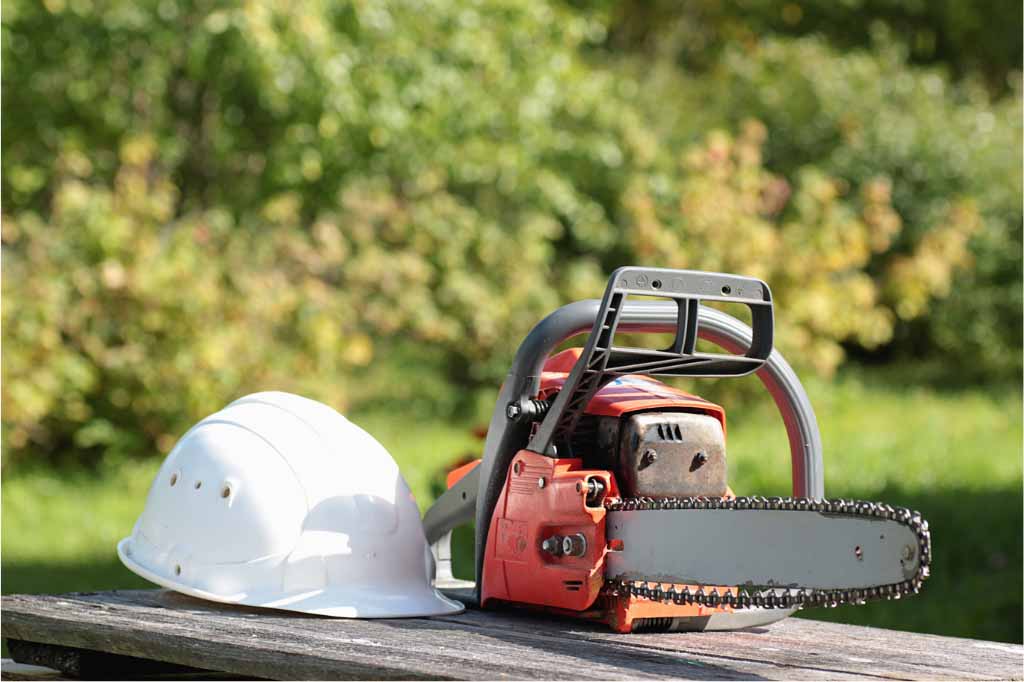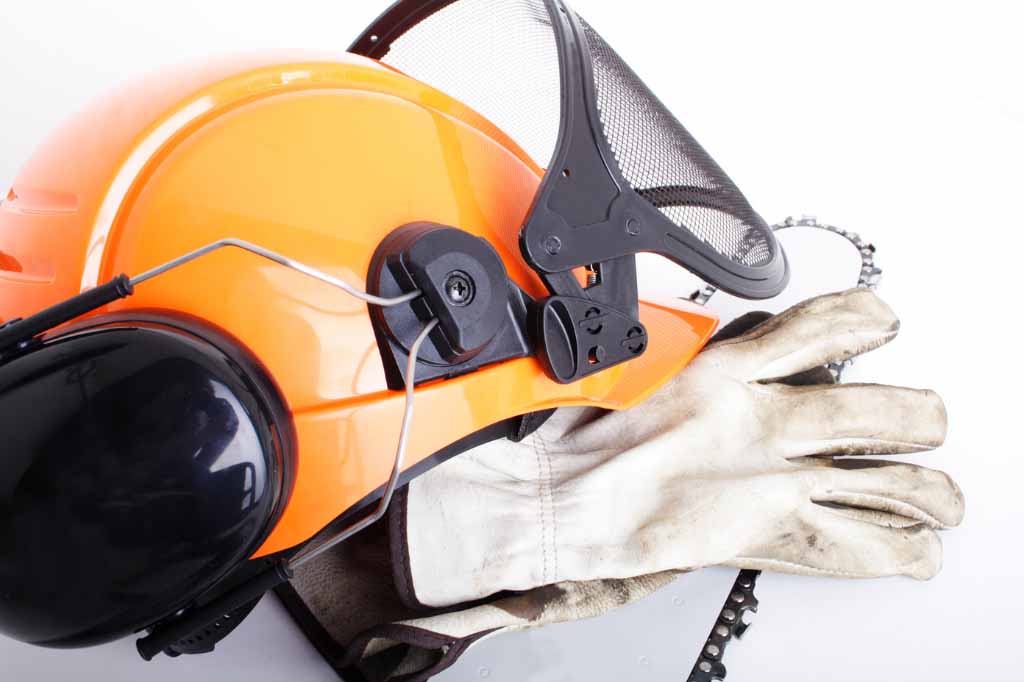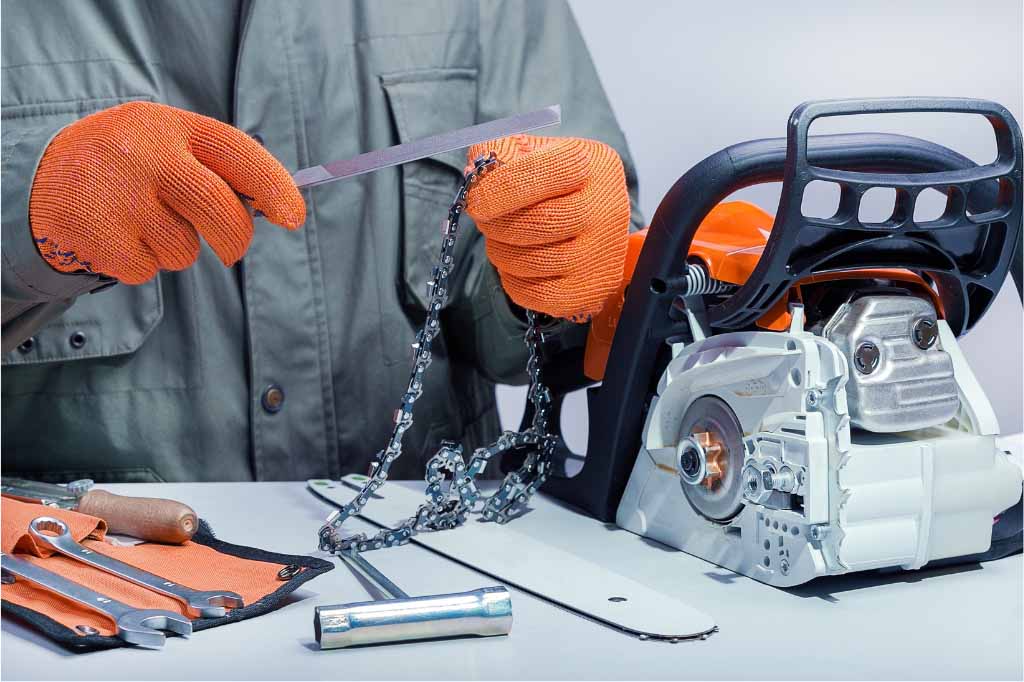A frequently recurring question that pops up in the mind of every chainsaw user is how tight should a chainsaw chain be. This question is a result of the chain constantly becoming loose and thus causing the work to be paused. Such a pause can reduce efficiency and work morale and irritate the user. To help our readers, Tools Detail has prepared a customized user guide that will give you the answer to how tight should a chainsaw chain be. However, before we get started, it is vital that the readers are frequented with chainsaw basics. So let’s get started!
What is a Chainsaw?
A chainsaw is a tool used for wood cutting purposes; however, unlike other wood cutting tools, a chainsaw performs more complex functions. Chainsaws can be powered by gasoline or electricity and even batteries. What makes a chainsaw such a useful tool in any situation is its portability.
The intense wood cutting is performed by its sharp teeth that are wrapped around in a chain. When choosing a chainsaw, it is vital to consider the teeth before making your buying decision. A sharpened chainsaw is a perfect tool to cut through rough pieces of logs. However, users must be careful since a slight mishap can lead to very detrimental effects on their bodies.

How Does a Chainsaw Work?
Before learning about how tight a chainsaw should be, it is essential to understand how it works. This can make you aware of what you are getting into and can also prepare you for all that is to come.
The answer to this cannot be summarized. This is because the performance of a chainsaw does not depend on the tool as a whole. Instead, it is the contribution of several parts coming together that make the tool capable of working. Let us see each of these parts in detail and find out how each of them assists the work of a chainsaw.
Engine
The engine of a chainsaw is what prompts it into action. You can thus conclude that without an engine, a chainsaw is as good as dead. The engine gives power to a chainsaw and prompts it into action. It is what enables the chainsaw to receive the power needed to cut through rough materials. There are several engines that can get the job done. The best of these is a gasoline-powered engine and an electric engine. Both of these are incredibly powerful, and you can choose them according to your budget and preference.
Carburetor
Remember the teeth that go around in a chain shape? They would be immobile without the carburetor of a chainsaw. The carburetor allows the chain of the teeth to rotate in circular motions in order to enable powerful cuts.
Drive Mechanism
The drive mechanism holds the secret location of the clutch of a chainsaw. Why is it important? A clutch signals the chainsaw to halt all operations in the case of a potential kickback. This protects the operator from injuring themself. In such a case, the operator is required to check if the chain and the teeth are sharp enough to prevent any further kickbacks. They must only resume operations when the answer to the previous check is positive. If that is not the case, operations must be halted until the teeth are made sharp again.
Chain Brake
The chain brake assists the clutch in performing its functions. It is the chain brake that receives the signals of the clutch and stops the chainsaw from moving in case of a kickback.
Cutting Chain
How can we talk about the operations of a chainsaw and not mention the cutting chain? A cutting chain is a chain that enables the cutting to take place. It is necessary to pick a chain that has sharp teeth, so you do not have to change it often. A sharp chain offers a variety. It can allow you to cut not only softwood but also rugged pieces of wood.
When all these materials come together, they form a fully functioning chainsaw. Each part has a hand in enabling a chainsaw to perform its operations. The engine is like the start button, which relays power to the carburetor. It is from here that the energy is spread to the entirety of the chainsaw and gets the chain spinning. Once the spinning becomes fast enough, any material can easily be cut through the blades on a cutting chain.
How Tight Should a Chainsaw Chain Be?
There is no exact rule regarding how tight should a chainsaw chain be. The ideal situation is where the chain is neither too tight nor too wobbly. The path to this situation, however, is very tricky. Getting it right can get close to impossible, but we have got a solution to that.

The following 2 tests can be run when tightening a chainsaw so that it achieves the ideal level of security.
Snap Test
For the snap test, you are obligated to pull the chain as away from the chainsaw bar as possible. Once you are at a considerable distance, let go of the chain. The key here is that your chain should readjust itself at the exact same position it was moved from. If you cannot pull the chain away, then it is a signal you have tightened it too much. On the other hand, if you release it and it does not fit well around the bar, it is too loose.
Pull Test
The most widely used way to answer how tight should a chainsaw chain be is a pull test. With the pull test, you need to pull the sidelines of the chain away from the bar. If such a case is impossible, then you have tightened the chain too much. You need to check whether the chain is completely getting detached from the bar. If this happens, it’s a sign that the chain is still very loose. The accurate answer to this test would be when only the part you are pulling can get away from the bar. In other words, its ends should still be in close proximity to the bar. This means that you have effectively tightened the chainsaw.
How to Tighten a Chainsaw?
Understanding how tight should a chainsaw chain be is worthless when you do not know how to tighten it all together. Once this query has been marked off the list, it becomes easier for you to follow the guide on how tight should a chainsaw chain be.
Step 1: Locate the nut face near the base of the chainsaw
Not only do these nuts hold the whole chainsaw in place they also play a crucial role in determining the right tightness of a chainsaw. Their numbers depend on the chainsaw you have. The maximum number they can go up to is 3, and the minimum count is 1.
Step 2: Loosen the nuts
A point to remember with this step is that you are not required to take out the nuts. All you have to do is get a scrench and give it a slight turn after inserting it in the nut face. Make sure they are loose enough so that you can adjust the chainsaw bar for the correct stiffness.
Step 3: Tighten the tensioning pin of the chainsaw
You will find that the tension pin is located slightly below the nut you just loosened. Insert your screwdriver in the pin and turn it in a clockwise direction. What happens with this approach is that the chainsaw bar is pushed out so it can fill the bare space between the bar and the chain. On the days when you are making the most use of your chainsaw, make sure that you follow this technique at least twice or thrice. This prevents any outcomes that can arise with the loose chain.
Step 4: Check whether the tightness is up to the mark
This is where your newly acquired knowledge comes into action. Employ the tips you learned above to check if the tightness of the chainsaw is what was required of you. If you still feel a gap somewhere, tighten the pin further to leave no loose ends.
Step 5: Retighten the tensioning pin and the nut
The last part is the most integral one and, unfortunately, the one that people forget the most. It is integral to retighten both the tensioning pin and the nut that you loosened for your work. If you fail to do so, then the friction in the chainsaw can cause them to rotate, further loosening it. Thus, remember to retighten both the elements so your newly tightened chainsaw stays intact and you can work without any pauses.
How to Use a Chainsaw Safely?

Use a chainsaw that has chain brakes
As mentioned above, a chain brake immediately stops a chainsaw from operating when a kickback occurs. This keeps the operators safe and away from potential dangers.
Read the manual
Reading the manual may seem like a hefty task, but it is highly essential. The manual contains all the dos and don’ts of operating a chainsaw properly. It even shows you the control buttons so that you can quickly resort to them in case of an emergency.
Protective Gear
A chainsaw can launch several unwanted elements toward you, which can lead to injuries. A chainsaw itself is a threatening tool that can seriously harm you. The protective gear keeps you safe from any potential accidents with a chainsaw that can land you in the hospital. A proper set of protective gear includes a chainsaw helmet, cut protection gloves, goggles to protect eyes, cut protection shoes, and cut retardant trousers.
Cut Below Waist Level
The risk of injuring oneself looms over operators at all times. Thus, they should opt for cutting activities that minimize the chances of such injuries. One such act of caution is cutting below the waist. This gives them maximum possible control over their chainsaw, which in turn reduces prospects of harm.
Sharpen and Lubricate
A sharp chainsaw eradicates any prospects of kickbacks. This keeps the operator safe from any flying object finding its way to their body. Lubrication is another factor that you must keep in mind at all times. When a chainsaw is working, it leads to intense friction being passed throughout the tool. Thus, if the tool has not been appropriately lubricated, the friction may eventually burn the chain of the chainsaw.
Clean the Air Filter
The air filter allows the carburetor and engine to receive clean air for operations. If this air is contaminated with dust or other unwanted particles, it can lead to wear and tear in your equipment. This can cause it to act out while you are working, ultimately leading to injuries.
Safety Stance
It is this safety tip that most users miss out on and then suffer grave consequences. The ideal stance when using a chainsaw is with the feet slightly apart and staggered. In addition to this, you must keep the saw close to your body for increased control over it. Other than the control, it is also the safest way to hold a chainsaw.
Follow the Do Not List
As its name suggests, the do not list contains all those points that you must avoid at all costs when using a chainsaw. These include:
- Do not use a chainsaw when any of its parts have been damaged. In addition, loose and missing parts are also red flags.
- Do not start a saw while you are holding it in your hands. When the chainsaw finally starts, it spreads a lot of friction which can cause you to move it unintentionally. This can lead to dangerous cuts on your body.
Final Words
A chainsaw is not a tool that can be dealt with casually. Moreover, maintaining a chainsaw is also not an easy task. Thankfully though, you do not have to fret about these things. Our user’s guide not only answers the most frequently asked question of how tight should a chainsaw chain be but also gives you other important tips to handle a chainsaw effectively.

